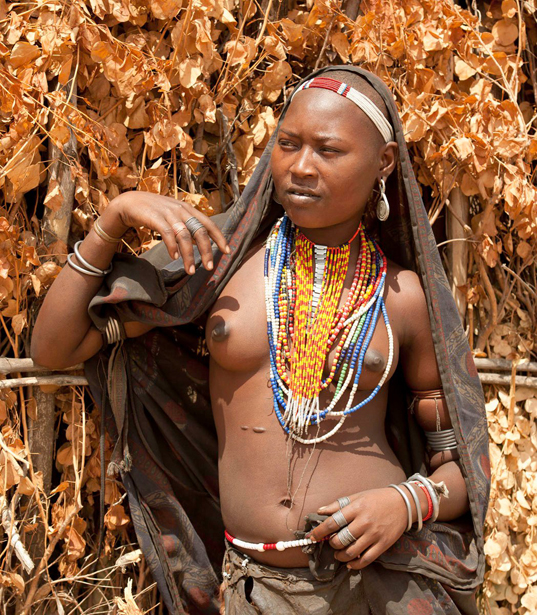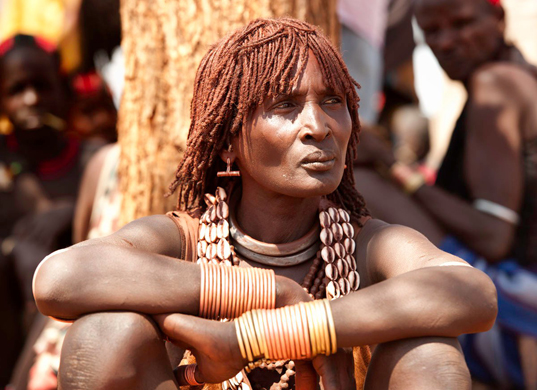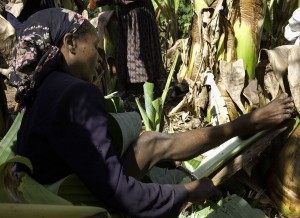Oh, to be a Hamer woman, hair in ochre ringlets glistening with fat that drips down her neck, staining earthy red the heavy metal necklace squeezed tight around her neck. Or the pride of the Mursi tribe, with a 4-inch plate stretching her bottom lip until it could be the coaster for a husband’s beer glass. Or a proud Beni wife, body covered in large welts, the scarred reminder of the night she showed her love for her future husband by allowing her arms, back, legs, belly to be whipped until she bled. And then begged to be lashed some more in a show of extreme devotion destined to win his heart. And of course his family’s cows.
We’ve been in the Omo River valley this past week, and all standards of beauty, conduct and dress are out the window.
Take the Erbore hut we visited, home to the elderly hamlet chief and his extended family. The hut looked like most of the ones we’ve been driving by, a humble stick and thatch affair sitting like a mushroom cap on the hard-baked flat ground. I expected to find one large room in which everyone lived and all activities took place. Wrong. First we entered the foyer, divided into a food-prep area on one side, and a men and boys lounge on the other. Its flat roof is barely 6-feet high, a lattice of leafy branches that provide shade, but also lots of light. The main equipment in food prep is a mildly dished block of granite which is used to grind millet seeds into flour. The chief’s wife put her shoulder to the task, kneeling in front of the stone, pushing the flat pestle along the length of the stone with all her weight on it, her elongated breasts, sucked dry years ago, swinging in time to her movement like two long brown leaves swaying in the breeze. Except there was no breeze and I stood over her sweating like a pig while she worked. Not a comfortable situation in several ways. For those who feel challenged concocting a one-pan dinner, here’s a reminder that less can be more, as the only other items for food prep were a couple of plastic bottles and a few large gourds. In the men’s lounge, the males of the group were doing what they do best, lying around on the charpoy, chewing on sticks and laughing.
Stooping under an opening about 4-feet high we enter a smoky, high-ceilinged space, part of the hut proper. This is where the cooking and eating are done and there’s enough smoke from what must be embers smoldering somewhere that my eyes start to sting immediately. I suppress a cough, thinking that’d be rude.. It’s hot as a pizza oven and I can feel my skin starting to bake. Thank goodness it’s so dark no one can see the sweat trickling from my armpits and the backs of my knees.
I ignore my growing crustiness, intent on learning as much as I can while I can bear it. In the stifling blackness,I can just make out the dark-skinned chief in a nearby pitch black corner. He’s perched on what he tells us is his personal stool, which never leaves that particular spot. His wife’s stool, lower than his of course, is placed beside him, but is allowed to move around. This is clever, as without such a law, she’d never be able to cook and serve him. And it’s not worth being a chief if you’re not going to be served. Do not think Queen Elizabeth’s throne when you think about his important stool. It’s just a three legged affair with a seat tacked on. Though nothing fancy, it clearly denotes rank and is something of which the old gentleman is rightly both proud and protective.
Behind him, he gestures, is his bedroom. This is private, shared only by his wife. It has a tattered floor mat in it, at least I think that’s what it was, many feet of gloom and now copiously tearing eyes interfering with precise vision. Separated from his room by a hanging mat is a similar sized space, the room for other husbands and wives. And next to that is the room for unmarried girls and children. I’m happy with our hot little tour. Now I know that the simple huts I’ve been seeing might actually be 4-room homes with a sun porch and open-air kitchen. I confess that, even though we pay the chief to visit his home, I find it authentic and fascinating. Not only is there a nice voyeuristic appeal to it, but I like to see how people really live. And also, in this particular case, I was able to observe just how desperate Bernard became in the smoky heat, uttering polite but pointed statements about how it was now time to move to the next part of the visit, which entailed him photographing bare-breasted women out in the broiling sun to which under normal circumstances he would have been doing anything possible to avoid being exposed.
It’s bloody hot in the Omo, 110 degrees at times. It’s not like the Danakil, but it is a water-starved region with little growing, mainly thorn trees and those razor-edged, spiky plants that only a starving cow could love. And, sadly, there are lots of those around. Brunhilde’s air conditioning is not working, so we subside into hot, grumpy blobs by early afternoon, if we’re driving that is. If we’re not driving, we are cravenly grateful for any place that offers a cool trickle of water to splash over our bodies, or a tall shade tree whose leafy branches offer some hope of a breeze. Of course, we’re in parched country now and even thinking about water makes me feel guilty. If I turn on a tap, I apologize. To anyone.
Happily, we found shade, and lots of it, on the banks of the great, grey, green, greasy Omo River, all set about with towering ficus trees. While we sat panting in the shade below, which reduced the temperature to an only slightly less unbearable 90 plus humidity, Colobus monkeys sprang about the topmost branches, their white mantles fluttering like opera capes, setting the trees a-rustle with their shenanigans. From the high bank above the torpid river, I could easily see the snouts of crocs drifting mid-channel (that’s crocs as in the reptilian kind, not the shoe kind). Also keeping a careful eye on those crocs were two Goliath Herons. They’re like a Great Blue Heron, but probably three times as large, tall enough to look me in the eye, with a neck as thick as Tarzan’s liana.
We drove to a small, centrally located village called Dimeka, which has a bustling market every Saturday morning. With everyone walking from somewhere far away, the market didn’t get started till mid-day. We passed the time, since we were there way early, slouched on plastic chairs in a shady juice bar. This actually was just a concrete stall behind which the owner squeezed or pressed out his juice offerings into plastic pitchers and rinsed used glasses in…….I don’t want to think about it. To create a patio outside he’d lashed banana-leaf panels to poles with a blue and white striped plastic tarp above to cut the sun. It was crude, but it worked. We both had a fresh mango-pineapple juice, served in a tall glass mug with slices of the mildly acidic local limes. Delicious. Mixed juices are the rage here, with one fruit puree layered on top of the other to create a rainbow of colors. Across from us, two villagers were indulging in an avocado-mango juice, which is what I plan to have next time. Not only is the fatty lusciousness of avocado something I crave these days, but the color combination is gorgeous.
The market was held on a flat open field of red dirt, barren but for a handful of thorn trees. Hamer women, with their signature glistening ochre bangs and ringlets, clustered according to their wares, long strands of chunky yellow, green, blue and white beads ringing their necks, steel and copper bangles cinched tight around wrists and biceps, a supple goatskin decorated with cowry shells and beads draped from their waist. The young women had bare breasts that proudly pointed the way forward, the elderly had breasts that drooped like popped brown balloons to their navel. Regardless of age, these are a good-looking people, with strong faces and fine features. It was all I could do not to stare, so attractive are they. Bernard photographed, I wandered about casting surreptitious glances.
Each tree was host to its own particular offering: small beige eggs and glossy black and red chickens (the latter priced at $1.50 and that’s before the bargaining starts) under one, under another acacia honey and sour-smelling home-churned butter in coiled clay pots. Brown tobacco leaves bound with water reeds, along with the occasional bunch of herbs and mounds of 3-inch bananas under a third, bundles of hay under the fourth (we each hefted one and agreed they weighed about 50 pounds. If that doesn’t sound like much, put a sack of grain on your back and walk perhaps 20 kilometers on a bush track….). Out in the open were tarps with small mounds of deadly green and red peppers; just looking at them made my tongue burn. There was lots of hefting of chickens going on, inspection of honey, consideration of small tubs of rancid-smelling butter. We bought 20 tiny bananas fort 20 cents. Our purchase cleaned out the seller’s supply. She appeared stunned, not sure whether to sit out the day or start walking home.
Our last tribal visit was to the Mursi, who live within the boundaries of Mago Nat’l Park. The road to their village is rough and unimproved, with sharp rocks that I feared might be the end of Brunhilde’s abused tires, but the mountain air en route is cool and the back country in the park resembles the bush that I know from my safaris in the southern parts of Africa. They say there’s wildlife somewhere in the park, some lions, elephants, giraffes, zebras, but I have my doubts, as more reliable word has it that most have been poached to extinction.
The Mursi women have their lip plates off when we arrive, as we’re the first tourist car of the cay. This is not a pretty sight. A flaccid loop of skin hangs down to their chin, looking like a thin, wrinkly brown sausage. Having the lip loop is a right of passage when a girl reaches marriageable age. To make it a slit is cut at the base of the lower lip and a small plug inserted. This then is enlarged over time by inserting progressively larger plugs. Ultimately, the clay disk they insert is 4 inches in diameter and a half-inch thick with in indent around its perimeter where the lip tissue is held.
Everyone is happy to see us because we represent money. The Mursi, like all the other Omo tribes, have learned they can charge for their photo. And they do. We pay for every photo taken and to every person in that photo. Children and babies are discounted 50%.
As we wander around this cluster of ten huts, I see a woman lying on her side, her head nestled in an old woman’s lap. The old woman seems to be doctoring her eye. At first I think she’s sick, so I go over to see what’s going on. Turns out she’s having her eyelashes plucked out, another beautification ritual. I don’t know whether to wince or applaud. I also notice that many women have had their two front teeth, top and bottom, pulled out. No one explains why to me, but as a number of women have popped their lip plates in, hoping to create a photo op, I can see that the plate is big enough that it intrudes into the mouth somewhat, where those front teeth otherwise would be. Women aren’t the only ones going through painful procedures in pursuit of beauty. Men have intricate scarification patterns on their chest, twin rows of large welts of scar tissue starting on their pectorals, curling around their nipples and running down the center of their chest to the navel. The welts are raised by rubbing a butter-charcoal mix into the incision. Next time I squeeze my feet into too-tight high heels (do I own any of those?) I’ll remember what pain is all about.
Mursi huts are the smallest and lowest we’ve seen, with the entrance door a mere 3-foot high opening. I’d have to crawl in on my knees, if anyone were invite me to enter. No one does. Huts are made of thatch and river reed culled from the surrounding bush. The Mursi move every half-year or so following the water. They don’t seem to invest much in making their huts into a home. Nor are they concerned about taking those huts with them, as the old materials wear out quickly and the river is their Home Depot, with ample new materials whenever they need it.
Squatting down in front of one hut, I see a young girl inside. She smiles up at me, not yet defaced, oh, I mean beautified. She’s holding a tiny baby on her lap. The baby’s mother is outside the hut, grinding millet. She does this just like the Erbore chief’s wife, same stone, same grinder, even though there’s no connection between the tribes. The baby, she tells us, is seven months old. Judging by his size, though, he looks more like half that age. I don’t say this to imply the Mursi are malnourished. Far from it. Besides millet, the Mursi have cows for meat and milk. Everyone looks robust and healthy. Or perhaps only the healthy ones are still alive…
So, that’s my tribal experience. There are at least four times as many distinct tribes in the Omo River Valley as what we saw. But we were discouraged by the rampant commercialism that’s now attendant on visiting their villages, so we actively chose to stay away. Instead we stopped along the road to talk to and photograph people walking along who interested us. Although they, too, expected payment, at least it went right into their pockets. Except they didn’t have pockets.
Yesterday we left the Omo region entirely and began our long drive back to Djibouti. First stop is a lovely lodge in Yirga Alem. This is the verdant part of Ethiopia, with plenty of rain, good water, and bountiful produce. It’s a shock to be surrounded by such dense greenery again. This morning we went on a 2-hour ramble with a local 75-year old retired teacher, along the foot paths of the surrounding Sidama village. We walk through leafy banana groves, past rows of coffee plants, through shivering sugar cane plots, under guava trees hung with passion fruit vines. Every once in a while we emerge into a clearing with a Sidama hut. These are large and elegantly shaped, almost like an onion dome and spaced widely apart, each with its own close-cropped lawn. In each hut area there are a few tethered cows and goats responsible for lawn maintenance.
In this area the staple food is not tif, but rather the pulp from the false banana tree, which is a plant that looks like a banana tree, but is never fruit bearing. Instead, the stalks that form the trunk are used to make a flour-like substance, which can be baked into a dry crepe-like bread. Our private teacher takes us to a Sidama family he knows, who show us how this is done. First they hack a tree down at its root; the plant is so porous that it takes only one whack to sever it. Then, as if deconstructing a huge celery bulb (remember Sleeper?) they peel off each liquidy, fibrous whitish-green stalk and whack off the attached banana-like frond with another precise swing of that machete blade. The elongated leaf is used as livestock fodder.
Then the mother washes her feet, sits on the ground, and leans a curved slab of wood against the tree in front of her. She wraps a couple of banana leaves around her waist, tucking the ends around and between her legs like an apron. Pressing the top of the stalk against that curved slab with her clean foot, she scrapes all the watery, fibrous inner material off with a dull blade, leaving nothing but the stringy exterior. The latter will be dried and used to make a kind of sisal rope. The gooey, wet, shaved matter will be wrapped in leaves and buried for 40 days, where the cool, anaerobic climate under the soil will allow it to ferment.
Fast forward and it’s now Granny’s job to take that fermented material, which has turned a sandy color, and rub it between fingers and palms in the base of a shallow, trough-like wood bowl, to break down any remaining fibers. She then wraps it in a small cloth and twists with all the might in her small body, to extract what amounts to a quarter cup of remaining liquid. Thus dried, the paste is shaken through a sieve a couple of times till it resembles coarse flour. A pinch or two of precious salt is sprinkled over the grainy mound.
Now we all adjourn inside their hut. Once my eyes adjust to the darkness and smoke I can tell that the Sidama don’t do rooms. This is one big round space where everyone lives and everything takes place. Granny squats at the fire and fans the few coals under her blackened cooking dish to heat it. With her fingers she presses a small ball of that damp flour-like substance onto the hot plate, forming a long ellipse. She lets it cook a couple of minutes. In reality the heat is just a means to dry the paste further and impart some smoky flavor in the process. The resulting thin, flat cake is rolled up, like a narrow tortilla. When six or seven small rolls are done, Granny brings the plate over to us, raises her arms heaven-ward and prays fervently and loudly to God to bless the bread. We all say Amen. As part of the blessing ritual she then takes a bite from one of the roll-ups and offers the rest to one Bernard and one Dina, who both dreaded what awaited them, but after one somewhat gritty, charcoal-y bite said, “Hey, this is pretty good,” and finished the remainder.
-Dina















